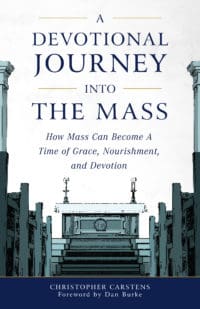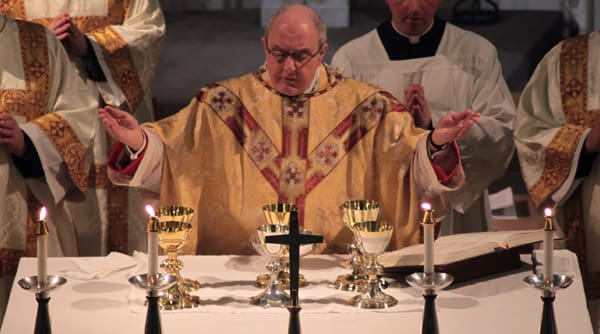You are a priest forever in the manner of Melchizedek.
— Psalm 110:4
Near the center of the ceiling of the Sistine Chapel in Rome, the famous image of Adam’s creation at the hand of God is a majestic reminder of our humble dependency on God for our very being. Whether as faithful pilgrims or curious tourists, the chapel’s guests can’t help but gaze up at this work of art. What do they see? Some see color, form, and beauty; others see faith and inspiration; and still others see beauty and faith commingled in some of Michelangelo’s more subtle meanings.
An interpretation of The Creation of Adam gives insight into liturgical participation, especially of the priestly sort. At the center of this central picture of the Sistine Chapel’s ceiling are God’s and Adam’s fingers about to touch, putting the capstone on the Trinity’s visible creation. But these figures are not yet touching, and the space between them — and the power to fill it — begins to speak directly about priesthood. The adjoining panels in the chapel’s ceiling help us to see why.
The fresco next to The Creation of Adam depicts Eve being created out of the side of the sleeping Adam, and the one after it depicts their fall from grace at the tree and their subsequent expulsion from the garden. These panels can be given a priestly reading by those fingers about to touch. If that first contact created life, and if the continued contact sustained and developed it, then Adam’s sin withdraws the human hand from God and ushers in death. Consequently, if fallen man and moaning creation wish to return to a new life, they must reach out and contact God once again. The gap — or, better, the chasm — must be bridged. And this is the job of the priest.
There are a few words our Roman Rite uses to describe its priests, and one of them is pontifex. In Latin, the noun pons means “bridge,” and we can see this word surface in such words as “pontoon boat,” which, in essence, is a small floating bridge. Fex is the foundation of today’s “factory,” the place where things are built. Put the two words together — pontifex — and you get “bridge builder,” which is precisely what a priest is. In this job description, a priest has the power to overcome the separation between humanity and divinity, allowing men and women to pass over to heaven and unite themselves with God. In terms of Michelangelo’s Creation of Adam, the priest bridges the gap between the outstretched fingers of God and man, a void that appeared because of sin.
Throughout history, many have noticed that things aren’t quite right with the world around us and have sought either a priest or at least priestly power to commune with the divine. In fact, the priestly instinct is a part of human nature, since our constitution is perfectly suited to reconnect heaven and earth. On the one hand, we share much in common with the rest of visible creation, since we are composed in part of a material body. We love dogs and cats, flowers and trees, clouds and air, food and drink. On the other hand, we resemble invisible creation, the angels, since we possess immaterial souls.
We desire to know and seek justice, we love (or at times hate) one another, and we are universally dissatisfied with the superficial happiness that material possessions bring. We look like animals but think like angels, with one foot in the earthly world and another in the heavenly world, and so we occupy a unique place in all of creation to bridge, mediate, and intercede between the opposite sides of the abyss separating us from God (see CCC 355). Some in the Church’s Tradition have even called man not Homo sapiens (since we are often as foolish as we are sapient), but Homo adorans, the “worshiping man.” But we are also fallen “priests of creation” and are in need of a supernatural cure for our priestly shortcomings.
A key thread throughout the Old Testament — perhaps the key thread — is the formation of priests. The Trinity works to restore and perfect the priesthood, both individually and collectively, a work that reaches its perfection in Jesus, the greatest bridge builder of them all, the Pontifex Maximus. Let’s consider a few of these priests of the Old Testament and how they led the Chosen People to pass over to God.
Something of a mystery man when it comes to priests in the Bible, the figure of Melchizedek is a remarkable example of how the sacerdotal is able to bridge the gap between man and God. It should come as no surprise that Melchizedek has much in common with the Christ yet to come. First, he is not only a priest but also a king, just like Jesus, and he’s not any old king either, but the royal head of Jerusalem, the place where Christ will one day offer Himself. According to the Letter to the Hebrews, Melchizedek is also “without father, mother, or ancestry, without beginning of days or end of life; thus made to resemble the Son of God, he remains a priest forever” (7:3). He also offers bread and wine, which Jesus will also do at the Last Supper. The fourth-century Doctor of the Church St. Ambrose saw in Melchizedek’s offering a universal sacrifice, one given in all times and places (“from the rising of the sun to its setting,” as the prophet Malachi would put it [1:11]). Melchizedek would be making an offering not bound to the future Temple of Jerusalem and its restrictive priesthood of a single tribe, the Levites. Rather, Melchizedek’s priesthood reaches further than Adam’s hand. In other words, this priesthood is big, one that calls the universe’s priests — men and women — to their original place as adoring bridge builders.
Serving as another type of priest is Abraham, whom the priestly Melchizedek blesses in God’s name. A different sort of priest from Melchizedek, Abraham (or, Abram, his original name) was called by God from a foreign land and promised blessings and descendants. He routinely builds altars and offers sacrifices to God (e.g., Gen. 12:7; 12:8; 13:18), and through these altars and their sacrifices made by Abraham the priest, heaven and earth one day would be rejoined. (Altars, sacrifices, and priests are always found together.) Abraham’s most significant sacrifice was his only son, Isaac, who was most dear to his heart.
God tells Abraham to “offer him up as a burnt offering on one of the heights that I will point out to you” (Gen. 22:2). Isaac travels to Mount Moriah on a donkey, carries the wood of his death up the mountain upon his shoulders, and freely gives himself over to his father’s hands. This domestic or paternal priesthood, to be passed from father to son, was present from the start. Already naturally born priests, God’s people were called upon to offer priestly sacrifice as the means to unite themselves — finger to finger — with the hand of God.
A third kind of Old Covenant priest, Moses leads his people from worldly woes to a new life. Standing at the head of his people (“in the breach” between God and the Israelites, Psalm 106:23 says), he directs the fathers of households to sacrifice an unblemished lamb to ransom their firstborn children. With the blood of the lamb marking the doorways of their homes, the Lord passes over their houses, sparing them. The next day, Moses, with staff (a type of cross) in hand, leads the Jews out of Egypt’s slavery, passing through the Red Sea to freedom and new life on the opposite shore. This entire people, God says to them, “will be to me a kingdom of priests, a holy nation” (Exod. 19:6), the conduit through which heaven and earth will one day reconnect.
In all these early prefigurements of Christ’s priesthood, “passing over” from one state to another and reconnecting with God is a vital element. The crossing of the Red Sea is, until the coming of Jesus, the most significant passover, where the journey from point A to point B is the result of priestly bridge building between man and God. But it is not the only example of pass-over. After forty years of desert wandering, for example, Joshua (in Hebrew, his name is the same as Jesus) leads the Chosen People across the Jordan on dry ground, the waters of the river piling up on both sides of them, into the promised land at Jericho (Joshua 3). Elijah also passes over the Jordan at Jericho before being taken up in the fiery chariot to God. After Elijah rolls up his mantle and strikes the water, the Jordan again parts, allowing the prophet to cross. Only then did the “fiery chariot and fiery horses” appear and “Elijah went up to heaven in a whirlwind” (2 Kings 2:11).
In another example of passover, the book of Ruth relates how Naomi and Ruth, living east of the Jordan River in the land of Moab, hear that the Lord has visited His people in the land of Judah “and given them food” (1:6). Then, crossing over the Jordan, they enter Bethlehem (the name means “house of bread”) and receive abundant food from Boaz — so much food, in fact, that they gathered the leftovers. (Does this account remind us of another priest from Bethlehem who gave food in abundance?) In each of these three instances — Joshua, Elijah, and Naomi and Ruth — we see bridges, passovers, and journeys from slavery and hunger in this earthly life to refreshment and new life with God. Each example recounts priestly actions of bridge building and reconnecting God and man, fingertip to fingertip.
These Old Testament priests and their meditations find fulfillment in the Pontifex Maximus, Jesus Christ. Like Melchizedek, the eternal Jesus offers bread and wine in Jerusalem. Like Abraham, He obediently offers His heart to the Father on the wood of the Cross. Like Moses, Jesus “stands in the breach” between God and man and builds a bridge from earth to heaven so that we can pass over to God. His redemptive bridge building is called the “Paschal Mystery,” and it includes His suffering, sacrificial death, Resurrection, and Ascension to the Father’s right hand. Because Jesus’ priestly Paschal Mystery is the high point of His saving work, it is naturally also at the heart of the Mass.
Our devotional journey into the heart of the Mass has taken us to the Sacred Heart of the Redeemer. His heart is, as it were, a bridge, over which we pass from earth to heaven. Consider the type of bridge builder Jesus is, and why we call Him the greatest of all. If the bridge of all human desire connects earth to heaven, rejoins man to God, Jesus is the only one who could build it, since He works perfectly for both sides of the void. He is, on the one hand, entirely God, the second Person of the Blessed Trinity. He has every authority and power to reach out from heaven to earth (much as Michelangelo depicted God striving for man on the Sistine Chapel’s ceiling). On the other hand, Christ is faultlessly, wholly, and completely man. But unlike that first Adam, who withdrew his hand from the life-giving touch of God, this Second Adam does not collapse under the weight of misguided desires but wills nothing but union with God. Christ the God-man is the true High Priest who bridges the great chasm created by sin. Is there a greater bridge — or bridge builder — imaginable?
With this image of the bridge builder in mind, let us return to Mass. During the Eucharistic Prayer, this great bridge opens before us. Jesus has the power to reconnect both sides, and the material He uses is His heart, the great gift that fills the space between heaven and earth. His Cross is the altar, the location — the X that marks the spot — where His heart is placed. As a willing agent in the Paschal Mystery, His ordained priest makes the Pontifical Jesus present. But even though Jesus is the offering, the altar, and the priest in history’s Paschal Mystery at Mass, He still desires our assistance. Christ the High Priest is always the principal worker in the Mass, but He calls all — the ordained and the baptized — to be His co-workers, salvation’s cooperators, priestly collaborators.
But who is this willing accomplice in the Paschal Mystery? Ordination to the priesthood conforms a man to Christ the priest and gives him unique power to exercise Jesus’ priesthood at the head of the Church. Long before ordination, that man began participating in Christ’s priesthood in virtue of his baptism. In addition to removing all sin, the sacrament of baptism gives a number of saving gifts: divine life of grace, gifts of the Holy Spirit, membership in the Body of Christ, and a share in the priesthood of Christ. All of the sacraments help us look and act and think and be like Jesus. And since priesthood is one of Christ’s characteristics, so too is it a Christian characteristic.
If Christ is the Pontifex Maximus, then you and I and each of the baptized is a pontifex minimus, a “little bridge builder.” Our bridge is the same one that Christ builds, a bridge to which we contribute by offering ourselves. Baptismal character empowers us — and demands of us — to exercise Christ’s priesthood in ourselves.
The sacrifice that God wants is our whole heart. But He won’t reach out and take it against our will, nor will the priest at Mass. To get my heart to the Father, I join it to Christ’s on the altar that serves as the crossroad between heaven and earth. And since Jesus is the priest who empowers me to act, I actualize His priesthood in myself. In Mass, as the preparation of the altar and the gifts concludes, the priest commands us to pray that his sacrifice and ours be acceptable to God. Assuming a priestly posture, we stand “in the breach” and say: “May the Lord accept the sacrifice at your hands for the praise and glory of his name, for our good and the good of all his holy Church.” The Eucharistic Prayer that follows is the time to roll up our sleeves and usher our prayers, works, joys, and sufferings over the great bridge with Jesus. St. Leo the Great once put it like this:
For all, regenerated in Christ . . . are consecrated priests by the oil of the Holy Spirit, so that beyond the special service of our ministry as [ordained] priests, all spiritual and mature Christians know that they are . . . sharers in the office of the priesthood. For . . . what is more priestly than to promise the Lord a pure conscience and to offer him in love unblemished victims on the altar of one’s heart?
Sacrifices need priests, and priests need sacrifices. After our hearts are prepared, the Eucharistic Prayer is the moment to realize our priesthood and join ourselves to God.
As daughters and sons of Adam, we were made to praise, adore, and mediate on behalf of creation. As brothers and sisters of the Second Adam, our natural desires attain supernatural power, enabling us, with the help of Christ, to redirect a fallen world to the hand of its Maker. As priests of creation, we point to the Father, who in Christ is no farther than our fingertips. Like the snapping synapses that flash between living cells in the body, the Paschal Mystery’s priestly bridge illuminates our journey’s main junction: the reunion of heaven and earth.
The word “liturgy” has at its root the word “work.” Bridge building is in large part the work taking place at Mass. But this labor also has its reward: much as the Chosen People’s crossing over the Jordan gave them the new land’s milk and honey, or as Naomi and Ruth’s passage gave them Bethlehem’s bread, so our own work in the Eucharistic prayer will yield food: the fruit of the tree of the Cross.
+
This article is from a chapter in A Devotional Journey into the Mass by Christopher Carstens which is available from Sophia Institute Press.
Art for this post on the Eucharistic Prayer: Bishop Alan Hopes during the Eucharistic Prayer, James Bradley, 13 January 2011 own work, CCA-SA 2.0, Wikimedia Commons; Cover of A Devotional Journey into the Mass used with permission. 





